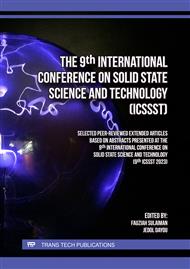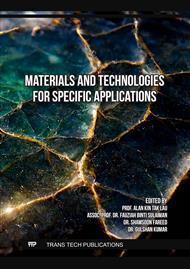[1]
R. Wood, M. Williams, A. Kavcic, and J. Miles, "The feasibility of magnetic recording at 10 terabits per square inch on conventional media," IEEE Trans Magn, vol. 45, no. 2, p.917–921, 2009.
DOI: 10.1109/TMAG.2008.2010676
Google Scholar
[2]
R. Dittrich, T. Schrefl, D. Suess, W. Scholz, and J. Fidler, "Nonuniform thermal reversal in single-domain patterned media," IEEE Trans Magn, vol. 40, no. 4 II, p.2507–2509, 2004.
DOI: 10.1109/TMAG.2004.834204
Google Scholar
[3]
Z. M. Yuan et al., "Perspectives of magnetic recording system at 10 Tb/in2," IEEE Trans Magn, vol. 45, no. 11, p.5038–5043, 2009.
DOI: 10.1109/TMAG.2009.2029599
Google Scholar
[4]
S. Jeong, J. Kim, and J. Lee, "Performance of bit-patterned media recording according to island patterns," IEEE Trans Magn, vol. 54, no. 11, p.1–4, 2018.
DOI: 10.1109/TMAG.2018.2833099
Google Scholar
[5]
S. Jeong and J. Lee, "Modulation code and multilayer perceptron decoding for bit-patterned media recording," IEEE Magn Lett, vol. 11, p.0–4, 2020.
DOI: 10.1109/LMAG.2020.2993000
Google Scholar
[6]
D. Weller et al., "Review Article: FePt heat assisted magnetic recording media," Journal of Vacuum Science & Technology B, Nanotechnology and Microelectronics: Materials, Processing, Measurement, and Phenomena, vol. 34, no. 6, p.060801, 2016.
DOI: 10.1116/1.4965980
Google Scholar
[7]
S. Chen et al., "Structure, magnetic and thermal properties of FePt-C-BN granular films for heat assisted magnetic recording," J Phys D Appl Phys, vol. 53, no. 13, 2020.
DOI: 10.1088/1361-6463/ab680d
Google Scholar
[8]
B. M. H. Kryder et al., "Heat Assisted Magnetic Recording," Proceedings of the IEEE, vol. 96, no. 11, p.1810–1835, 2008.
DOI: 10.1109/JPROC.2008.2004315
Google Scholar
[9]
J. G. Zhu, X. Zhu, and Y. Tang, "Microwave assisted magnetic recording," IEEE Trans Magn, vol. 44, no. 1, p.125–131, 2008.
DOI: 10.1109/TMAG.2007.911031
Google Scholar
[10]
T. Zhou et al., "Trapping electron assisted magnetic recording," IEEE Trans Magn, vol. 46, no. 3 PART 1, p.738–743, 2010.
DOI: 10.1109/TMAG.2009.2037331
Google Scholar
[11]
H. Yamane, S. J. Greaves, and Y. Tanaka, "Heat-Assisted Magnetic Recording on Dual Structure Bit Patterned Media," IEEE Trans Magn, vol. 57, no. 2, p.8–13, 2021.
DOI: 10.1109/TMAG.2020.3020088
Google Scholar
[12]
P. Khunkitti, N. Wannawong, C. Jongjaihan, A. Siritaratiwat, A. Kruesubthaworn, and A. Kaewrawang, "Micromagnetic simulation of L10-fept-based exchange-coupled-composite-bit-patterned media with microwave-assisted magnetic recording at Ultrahigh areal density," Micromachines (Basel), vol. 12, no. 10, p.1–7, 2021.
DOI: 10.3390/mi12101264
Google Scholar
[13]
J. Xu, M. Furukawa, A. Nakamura, and M. Honda, "Mechanical demagnetization at head disk interface of perpendicular recording," IEEE Trans Magn, vol. 45, no. 2, p.893–898, 2009.
DOI: 10.1109/TMAG.2008.2010670
Google Scholar
[14]
Y. Wang, Y. Zheng, Z. Zhong, Z. Wang, Y. Liang, and P. Wu, "Switching Diagram of Core-Shell FePt/Fe Nanocomposites for Bit Patterned Media," Materials, vol. 17, no. 7, p.2581, 2022.
DOI: 10.3390/ma15072581
Google Scholar
[15]
C. Das et al., "Thickness Dependent Surface Topography, Magnetic Properties and Magnetic Domain Structure of Amorphous FeTaC Thin Films," Journal of Material Science & Engineering, vol. 07, no. 03, 2018.
DOI: 10.4172/2169-0022.1000455
Google Scholar
[16]
M. Williamson, C. Wang, P. W. Huang, G. Ju, and M. Tsoi, "Large and local magnetoresistance in a state-of-the-art perpendicular magnetic medium," Nanotechnol Sci Appl, vol. 14, p.1–6, 2021.
DOI: 10.2147/NSA.S289055
Google Scholar
[17]
M. Tang et al., "Bulk Spin Torque-Driven Perpendicular Magnetization Switching in L10 FePt Single Layer," Advanced Materials, vol. 32, no. 31, p.1–8, 2020.
DOI: 10.1002/adma.202002607
Google Scholar
[18]
C. M. Cheong, "Recording Performance of Bit Patterned Media in Account of Demagnetization Field," AIP Conf Proc, 2023.
Google Scholar
[19]
C. M. Cheong and S. K. Chen, "The Critical Magnetic Field of Type-II superconductor On Account of Magneto-Interaction Field of Vortices," Solid state science and technology, vol. 24, no. 1, p.101–108, 2017.
Google Scholar
[20]
A. Kaidatzis, V. Psycharis, G. Giannopoulos, J. M. García-Martín, and D. Niarchos, "Magnetic anisotropy axis reorientation at ultrathin FePt films," Physica Status Solidi - Rapid Research Letters, vol. 11, no. 2, p.1–4, 2017.
DOI: 10.1002/pssr.201600386
Google Scholar
[21]
H. J. Richter et al., "Recording on Bit-Patterned Media at Densities of 1 Tb/in2 and Beyond," IEEE Trans Magn, vol. 42, no. 10, p.2255–2260, 2006.
DOI: 10.1109/TMAG.2006.878392
Google Scholar



